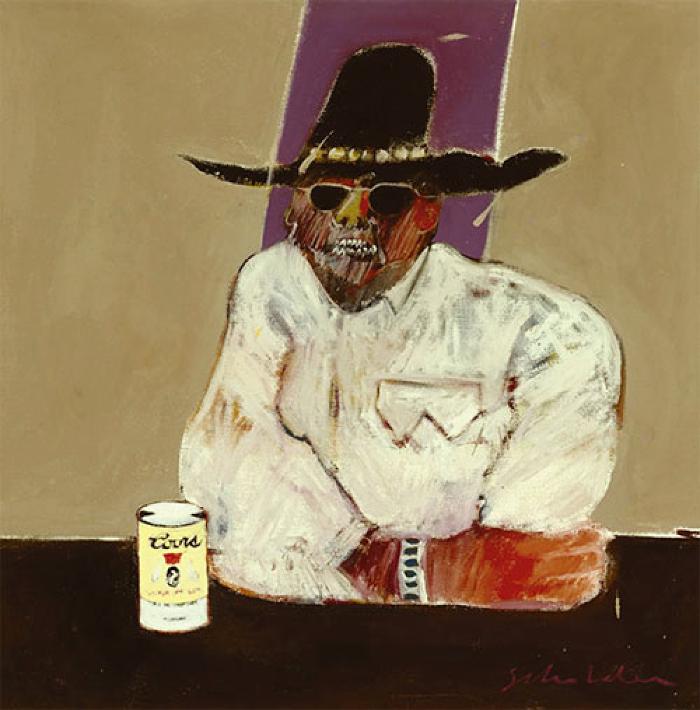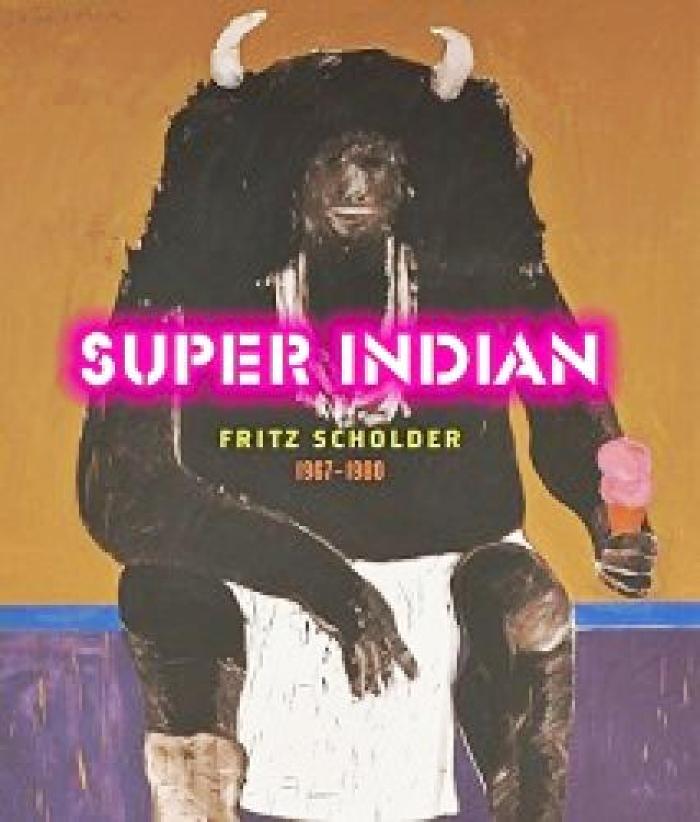 |
Canku Ota
|
 |
|
(Many Paths)
|
||
|
An Online Newsletter
Celebrating Native America
|
||
|
June 2016 - Volume 14
Number 6
|
||
|
|
||
|
Fritz Scholder: Super
Indian Still On Display In Denver
|
||
|
by Sandra Hale Schulman
- News From Indian Country
|
||
|
I don't like to talk about the work itself. I talk around
it. The work is visual; people can approach it on whatever level
they choose, and its meaning depends on their frame of reference.
That's what they are going to get out of it. - Fritz Scholder On display through June 17, 2016 at the Denver Art Museum, Super Indian: Fritz Scholder, 1967–1980 features more than 40 rarely seen, monumental paintings and lithographs by the renowned, sometimes controversial artist Fritz Scholder (1937–2005). This is one of the first exhibits to explore how Scholder mixed figurative and pop art influences to create colorful, compelling and revolutionary images of Natives in a way that had not been seen before – holding beer cans and ice cream cones, painted bright neon pink and draped in American flags with distorted faces. Influenced by abstract expressionists Willem de Kooning and Franz Kline, as well as painters with disturbing psyches such as Francis Bacon and Francisco de Goya, Scholder's work reveals the raw reality of being an American Indian through the eyes—and palette—of an artist who once vowed never to paint Indians. "Scholder claimed he was not an American Indian artist, but he was. He claimed his art was not political, but it certainly polarized the art world. For every position he took, he also explored the opposite perspective," said John Lukavic, associate curator of Native Arts at the Denver Art Museum and curator of Super Indian. "But this artist was first and foremost a colorist who used figurative art to test the limits of what paint can express." Following its Denver debut, the exhibition will travel to the Phoenix Art Museum and the Nerman Museum of Contemporary Art in Overland Park, Kansas. Drawing its title from the iconic painting Super Indian No. 2, the exhibition begins with Scholder's controversial Indian series, started in 1967, and ends with his 1980 Indian Land paintings, which marked a major shift in palette and subject matter. The exhibit showcases the evolution of his style and themes: Early Indian series, pop art, psychological portraiture, stereotypes and representation and dark, mysterious subjects. The central elements remain - the figure, vibrant color and energetic brushwork. The exhibition also includes two portraits of Fritz Scholder by Andy Warhol. Scholder broke almost every rule there was for an American Indian artist – if in fact there were "rules" at all. He combined pop art with abstract expressionism. He shunned the sentimental portrayal of traditional Indians and in so doing helped pave the way for artists who followed such as Brad Kahlhamer who contributes an essay to the show catalog. Scholder was one quarter American Indian, and when he created the work that put him on the art world map — his "Indian" series in the 1960s — he made people mad. The first painting had the word "Indian" stenciled on it, as if the image couldn't be identified without the label. Decades later, Scholder is the subject of three exhibitions across the country. The Smithsonian's National Museum of the American Indian has organized two — one in New York and one in Washington, D.C. — both called "Fritz Scholder: Indian/Not Indian." And in Santa Fe, N.M., where Scholder taught in the 1960s, the Institute of American Indian Arts Museum organized an exhibition titled "Fritz Scholder: An Intimate Look." The image that really made people take notice from Scholder's Indian series is Indian with Beer Can (1969). "It's still haunting; it's still devastating seeing these white teeth, a distorted face to suggest a skull," says exhibition co-curator Paul Chaat Smith, who works at the National Museum of the American Indian. "You can't see the figure's eyes, they're behind sunglasses — incredibly arresting and powerful work even today, but back then it was extraordinary." The can of Coors in the foreground is an in your face example of how Scholder painted what he saw - though that included alcoholism in Indian Country.
"He's really talking about the condition of the American Indian that he saw," says "Indian/Not Indian" co-curator Truman Lowe, at the National Museum of the American Indian. "And it's not pretty." But sometimes it's also funny as in the painting of the buffalo head dancer holding an ice cream cone. "We were at Santo Domingo Pueblo, and we had kind of left the crowd and walked around a corner, and here sat a buffalo dancer," recalls Scholder's second wife, Romona Scholder. Scholder decided to paint him. In the portrait, the dancer wears a horned headdress and beads around his neck. And in his hand — just as Scholder saw him — instead of the traditional rattle, there's an ice cream cone with two scoops.
"He went, 'Oh my God,'" says Romona, recalling her late husband's reaction to the incongruous sight. "And I think that that's why this painting is quintessentially Scholder — because he picked up that Indian-as-mythical-being and Indian-as-ice-cream-cone-eater." In the 1982 PBS documentary Fritz Scholder: An American Portrait, the artist discussed the origins of the "Indian" series. "I succumbed to a subject that I vowed I would never paint: the American Indian," Scholder said. "The subject was loaded, but here I was in Santa Fe. It was hard not to be seduced by the Indian." Scholder was one-quarter Luiseno, but he said he grew up "non-Indian." Born in 1937 in Breckenridge, Minn., he spent his childhood in North Dakota and South Dakota. In a documentary made on him, Scholder likened himself to the abstract expressionists: "The thing is to get the paint on the canvas. I don't care if you use your fingers, your rag, brushes, cardboard — it doesn't matter — it's getting that paint on the canvas. You get it on the canvas and you see what happens. It drips, it smears, it's thick or it's thin or you make washes. I consider myself a colorist. One color by itself isn't that interesting — it's the second color and a third color, and a dialogue starts and pretty soon you're swept up in it. You really don't know what's going to happen next." In 1964, he accepted a teaching position in Santa Fe and remained on the faculty through 1969. In the 1980s Scholder went to New York as part of his mission to make it, to become an art star. Andy Warhol painted his portrait. He went to openings and was embraced by an art world intrigued by his "otherness". In 1975, Scholder did a series of etchings called Ten Indians. Each portrays a different member of a tribe dressed in regalia. The last one is a Luiseno. It's Scholder — in sunglasses and an ascot. Indian or not Indian? Fritz Scholder remained both, right until the end. |
|
|
|
|
||
|
|
||
| Canku Ota is a free Newsletter celebrating Native America, its traditions and accomplishments . We do not provide subscriber or visitor names to anyone. Some articles presented in Canku Ota may contain copyright material. We have received appropriate permissions for republishing any articles. Material appearing here is distributed without profit or monetary gain to those who have expressed an interest. This is in accordance with Title 17 U.S.C. Section 107. | ||
|
Canku Ota is a copyright ©
2000 - 2016 of Vicki Williams Barry and Paul Barry.
|
||
 |
 |
|
|
The "Canku
Ota - A Newsletter Celebrating Native America" web site and
its design is the
|
||
|
Copyright ©
1999 - 2016 of Paul C. Barry.
|
||
|
All Rights Reserved.
|
||

